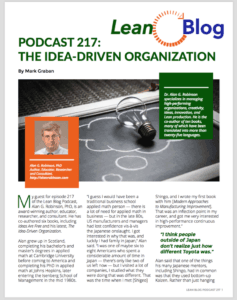
Today, we're looking back at a podcast that I did back in 2015 with Alan G. Robinson, PhD, co-author of many books including The Idea-Driven Organization. I'm talking about Kaizen today at the Studer Group annual “What's Right in Healthcare” conference, so I thought I'd share a new summary of the podcast episode.
Robinson highlights ThedaCare in the book. Last week in my webinar, I cited some of his research and Robinson's “80/20 principle” that finds about 80% of the improvement results in an organization come from small front-line staff-driven ideas… something that's counterintuitive to many.
Here is the podcast audio:
Podcast Summary:

You can also download a low-res or high-res PDF document of this summary.
My guest for episode 217 of the Lean Blog Podcast, Alan G. Robinson, PhD, is an award-winning author, educator, researcher, and consultant. He has co-authored six books, including Ideas Are Free and his latest, The Idea-Driven Organization.
Alan grew up in Scotland, completing his bachelor's and master's degrees in applied math at Cambridge University before coming to America and completing his PhD in applied math at Johns Hopkins, later entering the Isenberg School of Management in the mid 1980s.
“I guess I would have been a traditional business school applied math person — there is a lot of need for applied math in business — but in the late 80s, US manufacturers and managers had lost confidence vis-à-vis the Japanese onslaught. I got interested in why that was, and luckily I had family in Japan,” Alan said. “I was one of maybe six to eight Americans who spent a considerable amount of time in Japan — there's only like two of us left now — but I visited a lot of companies, I studied what they were doing that was different. That was the time when I met [Shigeo] Shingo, and I wrote my first book with him [Modern Approaches to Manufacturing Improvement]. That was an inflection point in my career, and got me very interested in high-performance continuous improvement.”
Alan said that one of the things his many Japanese mentors, including Shingo, had in common was that they used bottom-up Kaizen. Rather than just hanging up a suggestion box, his mentors were getting ideas from their frontline people using a system. That system interested Alan and has been a thread that has run through his consulting, research, and writing since then.
Japanese Culture and the Toyota Production System
Today, Lean systems are no longer just Japanese management systems, they are practiced around the world. But, reflecting on its beginnings, Alan noted just how unusual the system Toyota created was for its time and place.
“I think people outside of Japan don't realize just how different Toyota was.”
“This was not like General Motors decided to do this, or Bank of America,” Alan said. “This was a sassy start-up. The Japanese government tried to close them down a bunch of times by depriving them of raw materials or markets, that was mostly in the '50s, but this was an upstart company so you might want to think of, I don't know, one of these internet file sharing companies that got shut down,” like Napster.
Going out for drinks and food to talk business in the evening is also common in Japanese culture and Alan recalled being taken by one of his Japanese mentors to a bar after work. Seeing the learning opportunity, the mentor offered to eavesdrop and translate the conversations going on at the other tables to give Alan insight into Japanese business mentality.
“So, he cupped a hand over his ear and he said, ‘You must do better at work, you are not working hard enough.' It was an older manager with a younger female employee, and they were smiling and laughing, but it was deadly serious, hard hitting,” Alan said. “It is fascinating to me, and somebody has to write the history of this, of how this company sort of bucked a lot of its country's culture. It'd be like finding a communist collective in the United States being the most successful company, and it was situated in Colorado or someplace. Anyway, they did it and they showed the world how to do a lot of things better.”
History of Suggestion Programs
Alan explores history in many of his books. In both Ideas are Free, and The Idea Driven Organization, he touches on the origins of suggestion box systems.
“I love history, I read a lot of history. When I'm on airplanes or at the beach I like reading history books,” Alan said. “My theory is that any large organization, say of several thousand people, that was organized and functioning relatively efficiently, had to have some approach to listening to what was going on at Gemba so to speak, or they wouldn't be able to just keep it together.”
Command and Control Leadership
The other piece of the suggestion box history, Alan explained, is that it tracks very closely to mankind's battle with “command and control” leadership.
“Most people in the world, work in top-down command-and-control environments, and we all kind of know that, that's better than anarchy, but now they're much better models to manage, they get much better results.” Alan said.
“Most companies still use a suggestion box approach because it fits very well with command-and-control. It doesn't threaten the hierarchy at all, it never brings in too much feedback, too many ideas.”
I asked Alan if, after so many decades of leaders developing bad habits from being rewarded for having the answers, instead of for collecting, engaging, and supporting ideas from their employees, it is possible to convince leaders to change their mindset.
“T.S. Kuhn wrote about this in The Structure of Scientific Revolutions, that your success in the old paradigm makes it much harder to shift to the new paradigm,” Alan said. “I also have come to believe that command and control is just deeply rooted in the human condition. If you think about it, all through time we've had slavery, kings, serfdom, and Pharaohs, where this command and control's been the model.”
Alan has found that old-paradigm leaders, will change if there is a sense of urgency.
“Like you, I work a lot in healthcare. These leaders of modern healthcare organizations or hospitals, they don't really know what to do to survive,” Alan said.
“A successful pilot idea system is a great way for a middle manager to get the leader interested, show them that look at all the ideas that came out of this area, and look at what they're doing for you.”
The problem is quantifying it into terms the old command and control leaders have been used to because they deal mostly with financial results.
“They watched the numbers, that's how you keep control at a distance. But, many of these ideas are process ideas. Giving me this wrench makes it really difficult. My wrist hurts, and I can't work as fast. And they won't see that, but giving them a new wrench, so they can work faster and smile to customers, actually has a big impact on your bottom-line. They're trying to manage something with tools that are too primitive to pick up what they need to see,” Alan said.
Incentivized Suggestion Boxes
Offering financial incentives has been a way leaders have tried to get more suggestions in an old-style suggestion box system, but Alan explained this is simply not the way it works. Alan first saw this in Japan; the Japan Human Relations Association (JHRA), used to collect data on suggestion boxes from hundreds of large and mid-size companies. The data would include things like how many ideas were collected, what was the measurable impact, how much money was paid in rewards, how much was paid in rewards per idea, what percentage of rewards were used, and so on.
“The person who collected that data for years said, ‘It's so interesting, there's an inverse relationship, the more money these companies are offering, the fewer ideas they get.' And you can see it in the data,”
Alan said. “There is just lots of reasons why, and as I started to delve into it myself with the companies I was tracking and then dealt with, we just ran into all kinds of crazy stuff.
“First of all, if you set up a reward system and you say it's a percentage of the cost savings of revenue from an idea, that immediately means you have to calculate the cost of revenue from every idea.”
The figure from American Airlines was that it takes an average of four hours of an employee's time to put an accurate number on how much an idea saved Alain said. American Airlines ran a 10 percent reward scheme, at one time claiming that they employed 90 people whose only job was to calculate cost savings from individual ideas, which is only needed for the sake of giving rewards.
“If you look at a Toyota or an Autoliv, or a company like that these days, that's getting millions of ideas from their people, you'd need a whole other car company with bean-counters in it behind you to add up the individual revenue. It slows things down tremendously, Alan said. “We came across several Fortune 500 companies with ideas that were more than 10 years old, for that reason. Nobody wanted to put in that kind of time.”
One organization Alan worked with, Brookhaven National Lab, had a cost savings idea system. The COO told Alan that, the idea was submitted to use energy-saving light bulbs throughout the organizations 57 buildings, which were used by 5,000 people each day, and the organization owed the person who submitted the idea 10 percent by the union contracts
Alan and two others then we had to go around and count all the light bulbs because it couldn't just be calculated off the meter, because of the many other things that impact the electric bill, but the employee grieved the amount calculated.
“So, you end up with lots of disputes and a lot of overhead.” Alan said. “I had to put myself through the certified fraud examiner training course because I was seeing so much fraud. It's very easy to steal money. It happens in every reward-based suggestion system, whether they know it or not. We put a few horror stories in Ideas are Free, but they are by far the least shocking that we found.”
Intentional Overstaffing for Kaizen
Another prevalent issue for organizations trying to engage their employees, even those that are using bottom-up improvement systems, is lack of time. In Ideas are Free, Alan writes about companies like Scania intentionally overstaffing to work on Kaizen.
“Yeah, a lot of these companies get into that. Scania was trained to do that by Toyota, which does a lot of that over-staffing, they just make it look a little different,” Alan said. “There's a lot of very creative ways to make that time.”
To listen to our full conversation, read a partial transcript, find links to Alan's work and online spaces, and watch some videos featuring additional interviews, lectures and talks with Alan all together at www.leanblog.org/217.
Please scroll down (or click) to post a comment. Connect with me on LinkedIn.
Let’s work together to build a culture of continuous improvement and psychological safety. If you're a leader looking to create lasting change—not just projects—I help organizations:
- Engage people at all levels in sustainable improvement
- Shift from fear of mistakes to learning from them
- Apply Lean thinking in practical, people-centered ways
Interested in coaching or a keynote talk? Let’s start a conversation.





![When Was the Last Time a Leader Around You Admitted They Were Wrong? [Poll]](https://www.leanblog.org/wp-content/uploads/2025/07/Lean-Blog-Post-Cover-Image-2025-07-01T212509.843-238x178.jpg)



